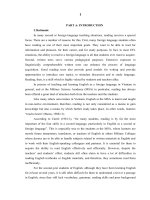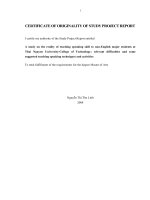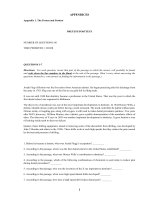Using the audiovisual translation mini project for advertisement videos to improve translation skills for second year english majors at Thai Nguyen university of education
Bạn đang xem bản rút gọn của tài liệu. Xem và tải ngay bản đầy đủ của tài liệu tại đây (255.12 KB, 7 trang )
ISSN: 1859-2171
e-ISSN: 2615-9562
TNU Journal of Science and Technology
225(03): 56 - 62
USING THE AUDIOVISUAL TRANSLATION MINI-PROJECT FOR ADVERTISEMENT
VIDEOS TO IMPROVE TRANSLATION SKILLS FOR SECOND-YEAR
ENGLISH MAJORS AT THAI NGUYEN UNIVERSITY OF EDUCATION
Do Thi Ngoc Phuong*, Lo Thi Phuong Thao
TNU - University of Education
ABSTRACT
This study aimed to find out whether using Audiovisual Translation (AVT) of advertisement
videos had effectiveness on improving translation skills for English majors at Thai Nguyen
University of Education. There were 20 second-year English majors attending in the AVT miniproject. They had to do pre-test and post-test in order to examine if there was any improvement in
their performance in their translation skill between the tests and answer an questionnaire for more
details about their attitudes towards this method. The results from the pre-test and post-test have
approved that there was a significant enhancement of the students’ performance in translation skill
after using AVT of advertisement videos. The figure from the questionnaire indicated that using
AVT of advertisement videos helped the students gain more vocabulary, reduce their grammatical
mistakes while writing English sentences and be more confident in translation than before.
Keywords: Audiovisual translation; translation; project; advertisement; video.
Received: 02/12/2019; Revised: 24/12/2019; Published: 21/02/2020
SỬ DỤNG ĐỀ ÁN DỊCH NGHE NHÌN CHO VIDEO QUẢNG CÁO
ĐỂ NÂNG CAO KĨ NĂNG DỊCH CHO SINH VIÊN CHUYÊN NGỮ NĂM HAI
TRƯỜNG ĐẠI HỌC SƯ PHẠM - ĐẠI HỌC THÁI NGUYÊN
Đỗ Thị Ngọc Phương*, Lô Thị Phương Thảo
Trường Đại học Sư phạm - ĐH Thái Nguyên
TÓM TẮT
Nghiên cứu này được thực hiện với mục đích tìm hiểu về hiệu quả của việc sử dụng hình thức dịch
thuật nghe nhìn cho các video quảng cáo đối với việc cải thiện kĩ năng dịch thuật cho sinh viên
tiếng Anh tại trường Đại học Sư phạm - Đại học Thái Nguyên. Với sự tham gia của 20 sinh viên
chuyên tiếng Anh năm thứ 2 vào đề án dịch thuật nghe nhìn (AVT), sinh viên phải thực hiện các
bài tiền kiểm và hậu kiểm để xác định được việc họ có cải thiện được kĩ năng dịch hay không.
Đồng thời việc tiến hành thu thập dữ liệu bằng phiếu điều tra cũng cho thấy thái độ của người
tham gia đối với đề án này. Kết quả từ tiền kiểm và hậu kiểm đã chứng minh được rằng sinh viên
có cải thiện được kĩ năng dịch sau khi tham gia đề án AVT đối với các video quảng cáo. Số liệu từ
phiếu điều tra cho thấy việc sử dụng đề án AVT đối với các video quảng cáo giúp sinh viên tăng
cường được vốn từ vựng, giảm thiểu được các lỗi ngữ pháp khi viết câu bằng tiếng Anh, đồng thời
giúp sinh viên tự tin hơn trong việc dịch thuật.
Từ khóa: Dịch thuật nghe nhìn; dịch thuật; đề án; quảng cáo; video.
Ngày nhận bài: 02/12/2019; Ngày hoàn thiện: 24/12/2019; Ngày đăng: 21/02/2020
* Corresponding author. Email:
DOI: />; Email:
56
Do Thi Ngoc Phuong et al
TNU Journal of Science and Technology
1. Introduction
These days, with the development of
technology, utilizing videos in teaching and
learning English has been risen as a new
method. Audiovisual Translation (AVT) is
one way to use the videos to facilitate the
learning process and boost the translation skill
for learners. According to Jennifer Lertola
and Cristina Mariotti [1], AVT “offers the
opportunity to maximize the benefits of
translation by developing not only reading
and writing but also listening and speaking
skills”. AVT can be distinguished into two
main categories: revoicing and subtitling.
Traditionally, it consists of the replacement of
original dialogues for translation into another
language [2], although, different language
combinations are also possible. There are
three types of the revoicing: muting the voice
of the original actors (dubbing), speaking
over the original voices (voice-over) or
commenting on the scenes (free commentary).
Dubbing was first used as an activity in class
in a study of Duff [3], when students had to
work in pairs to carry out different activities
around adapting a drama play to a film. This
practice continued years later with Kumai [4],
as the activity improved the students’
pronunciation, intonation and speed in oral
expression and motivated them in learning
process. Wagener [5] focused on the
“consecutive interpretation of perfect
synchronization” when dubbing and he
worked on skills such as listening, vocabulary
acquisition and independent learning.
Recent studies in relation to the use of AVT
techniques in foreign language teaching and
learning have shown various benefits of this
method. In recent decades, several authors
have declared that the use of video has a very
positive and motivating effect, offering
variety and entertainment together with its
pedagogical function [6], [7], [8], [9].
Different authors indicated a variety of
advantages in the use of AVT in foreign
language teaching in their works [6], [10],
; Email:
225(03): 56 - 62
[11]: the boosting of self-esteem and
confidence, the integration of the language in
a natural way; attentive listening as an
intrinsic element; the inclusion of verbal and
non-verbal communicative elements; the wide
variety of skills and learning areas that can be
developed using a specific type of AVT, or
several of them at the same time. Therefore, if
students make good use of the audiovisual
element in the learning process, they can
comprehend the target language more
effectively and develop other skills.
In this research, the researcher will
investigate the use of audiovisual translation
of advertisement videos, a specific type of
videos, in order to improve the translation
skills for second-year English majors at Thai
Nguyen University of Education.
This research is expected to seek for the
answers of these two questions:
1. To what extend does audiovisual
translation of advertisement videos improve
the second-year English majors’ translation
skill at Thai Nguyen University of Education?
2. What are the students’ attitudes towards
this method?
2. Methodology
2.1. Participants
The subjects of this study were the English
major students from the second-year class
(English K52) at Thai Nguyen University of
Education. There were 20 female students at
the age of 20-21 volunteered to take part in
the study.
2.2. Data collection instruments
In this research, there are two data collection
instruments to be used: tests and a
questionnaire.
2.3. Data collection procedures
Before the mini-project, the researcher had to
make sure that all the students who would use
audiovisual translation of advertisement
videos in practicing translation skill have
devices with internet connection such as
laptops or mobile phones.
57
Do Thi Ngoc Phuong et al
TNU Journal of Science and Technology
The mini-project was implemented to examine
the effects of using audiovisual translation of
advertisement videos in students’ translation
skills in blended learning environment. The
subjects were 20 students in class English
K52 at Thai Nguyen University of Education
during an 8-week period. The researcher
created a Facebook group including 20
participants, so that the researcher could
illustrate the effectiveness of AVT of
advertisement videos in students’ translation
skills by observing the procedure of the miniproject. The researcher instructed steps of
using AVT of advertisement videos for the
students in a face-to-face meeting, and then
required the students to dub and subtitle
advertisement in groups of 5 people at home.
The chosen advertisement videos that were all
in Vietnamese needed to be translated into
English. The researcher selected the videos
from simple and short in the beginning of the
mini-project to more complex and longer ones
in the end. The students were dubbing and
subtitling 2 videos a week. There was also a
meeting once a week in order to instruct the
students and help them to find the ways to
solve any problems that they had while doing
the mini-project.
3. Findings and discussions
3.1. Results from the tests
The students’ translation skill was measured in
the pre-test and post-test to determine whether
the AVT mini-project helped the students to
improve their translation skill. The scores in the
pre-test and post-test of 20 participants are
displayed in Table 1.
225(03): 56 - 62
Table 1. Students’ scores in the pre-test and post-test
Student
Student 1
Student 2
Student 3
Student 4
Student 5
Student 6
Student 7
Student 8
Student 9
Student 10
Student 11
Student 12
Student 13
Student 14
Student 15
Student 16
Student 17
Student 18
Student 19
Student 20
Score in
pre-test
3.8
4.0
4.0
4.3
4.5
4.5
4.5
5.3
6.0
6.5
6.5
6.5
6.5
6.8
6.8
6.8
6.8
6.8
7.0
7.3
Score in
post-test
6.0
5.0
5.8
5.0
5.8
6.3
6.0
6.3
6.0
7.5
6.5
7.0
7.0
7.3
7.3
7.5
7.3
7.8
6.3
7.3
The data from Table 1 reveal that there is a
rise in the scores of the students since the
gained scores are 95% positive numbers. In
detail, 19 per 20 students' scores (95% of the
students) remained the same or increased
(from 0.5 points to 2.2 points) in the post-test.
Table 2. Descriptive statistics for the students’
performance in the pre-test and post-test
Paired Samples Statistics
Mean
N
Std.
Deviation
Pre-test 5.7600 20 1.22921
Post-test 6.5500 20 .82876
Table 3. Results of the Paired Sample T-tests (P<0.05 level of significant)
Mean
Pair 1
58
pretest posttest
-.79000
Pair 1
Paired Samples Test
Paired Differences
95% Confidence
Interval of the
Std.
Std. Error
Difference
Deviation
Mean
Lower
Upper
.56279
.12584
Gained
score
2.2
1.0
1.8
0.7
1.3
1.8
1.5
1.0
0.0
1.0
0.0
0.5
0.5
0.5
0.5
0.7
0.5
1.0
-0.7
0.0
-1.05340
-.52660
t
df
-6.278 19
Std.
Error
Mean
.27486
.18532
Sig. (2tailed)
.000
; Email:
Do Thi Ngoc Phuong et al
TNU Journal of Science and Technology
In order to draw the conclusion that it was the
AVT mini-project that helped the students to
improve their translation skills, the researcher
used the Paired Sample T-tests in SPSS
software. The participants’ average scores in
the pre-test and post-test were calculated and
compared with each other.
As can be seen in Table 2, there was a
significant increase in the average scores of
the participants between the pre-test and posttest. In the pre-test, the students’ average
score was 5.76, and this figure rose to 6.55 in
the post-test, after 8-week-period of the miniproject. Moreover, the standard deviation in
the post-test stood at 0.82876, which was
lower than the standard deviation in the pretest (1.22921). This means that the gap
between students’ scores in the post-test was
smaller than the gap between students’ scores
in the pre-test. Therefore, not only the
translation skill of the participants was
improved but also the gap between their
ability in translation was narrowed after
participating in the AVT mini-project.
Alison Mackey & Susan M. Gass [12] pointed
out that “The accepted p-value for research in
second language studies (and in other social
sciences) is .05. A p-value of .05 indicates
that there is only a 5% probability that the
research findings are due to chance, rather
than to an actual relationship between or
among variables” [12]. In other words, the
significant value (p-value) of 0.05 is the
probability in which the alternative
hypothesis wrong is 5%. In the contrary, it
can be ensured that the alternative hypothesis
has 95% confidence of being true.
Table 3 clearly shows the effectiveness of the
AVT mini-project on students’ translation skill
since. The significant value, as being showed
in the table, was smaller than 0.05. This means
that there was a significant difference between
the scores in the pre-test and post-test.
Consequently, the results of the project with
the sig.value (p-value) is 0.000 (<0.05) were
reliable and the AVT mini-project did have
positive effects on students’ translation skill.
; Email:
225(03): 56 - 62
This finding implies there was strong evidence
against the null hypothesis. Thus, the null
hypothesis, which states there is no significant
difference in the translation skill of the
students before and after using AVT, is not
supported in this study.
3.2. Results from the questionnaire
3.2.1. The effectiveness of using AVT on
students’ vocabulary
Chart 1. Students’ attitudes towards the
effectiveness of using AVT on vocabulary
As can be seen in chart 1, there are 60% of
the students (12 students) agreed that their
vocabulary has enhanced in size after using
AVT of advertisement videos. The number
of the participants who said that their
vocabulary size has somewhat risen is 20%
(4 students), and that is the same data for
those who answered their vocabulary size
has expanded to a great extent. These data
show that using AVT had positive influence
on the students’ vocabulary as they gain
more words after the project.
Chart 2. The number of words gained from using
AVT of advertisement videos
59
Do Thi Ngoc Phuong et al
TNU Journal of Science and Technology
225(03): 56 - 62
Chart 2 reveals the number of words gained
that the students can estimate after using AVT
of advertisement videos in 5 weeks. Half of the
students believed they gained from 20 to 30
words from utilizing AVT of advertisement
videos. Meanwhile, 25% of them thought that
they gained from 10 to 20 words. The figure is
lower in the number of students who estimated
their vocabulary is added more than 30 words
(20% of the students), and there were only 5%
of them chose the option “0-10”. This result
indicates that all the students have improved
their vocabulary by using AVT of
advertisement videos.
3.2.2. The effectiveness of using AVT on
students’ writing skill
One of the problems that the learners have
while translating is the grammar, as each
language has different grammatical rules.
Chart 3 reveals if the students could improve
their ability in writing a sentence in English
more correct in terms of grammar.
mistakes than before, that means most of them
have improved their writing skill in English.
3.2.3. The effectiveness of using AVT on
students’ translation skill
Chart 3. Students’ confidence towards their
improvement in the ability to write sentences in
English with fewer grammatical mistakes than before
3.2.4. The students’ attitudes towards the AVT
mini-project
There was 20% of the students agreed that they
felt slightly more confident than before while
writing sentences in English in terms of
grammar. That number rose to 30% in the
option “moderately” for this question, as they
thought they might still make grammatical
mistakes sometimes. The highest figure was
35% for the option “very”. These illustrations
show that most of the students can write
English sentences with fewer grammatical
60
Chart 4. The students’ attitudes towards the
effectiveness of AVT mini-project on their
translation skill
Chart 4 presents the percentages of the
students’ attitudes towards the effectiveness
of AVT mini-project on their translation skill
All of the students agreed that the project
enhanced their translation skill. There were
10% of the participants who thought that
using AVT of advertisement videos helps
them to improve their translation skill
moderately. The percentage of the students
who believed that the project betters their
translation skill quite a lot was 45%, and that
was also the data for those who agreed that
their translation skill has been developed very
much thanks to the AVT mini-project.
Chart 5 shows how much the students enjoy
the AVT mini-project. It is noticeable that
more than half of the students were very
interested in using AVT of advertisement
videos and 30% of the students showed that
they were quite interested towards this
method. Only three students (15% of the
participants) have moderate interest in the
AVT mini-project. These data reveals that in
general the students like this project.
; Email:
Do Thi Ngoc Phuong et al
TNU Journal of Science and Technology
Chart 5. The students’ attitudes towards
the AVT mini-project
4. Conclusion
In this study, the effectiveness of the AVT
mini-project on the students’ translation skill
was investigated. It has been found that using
AVT of advertisement videos helped learners
improve their translation performance in tests.
The
students
translated
Vietnamese
advertisement videos into English by adding
subtitles and voiceover in the videos, and they
improved at a significant level from the pretest to the post-test scores.
The students’ writing skill became better after
the AVT mini-project. The students showed
their improvement in the videos with AVT, as
the researcher observed they wrote translated
text more correctly in terms of grammar. Not
only that, the participants recognized that they
could translate Vietnamese text into English
more smoothly and fluently, as they got used
to the AVT of advertisement videos. They all
agreed that their translation skill was
enhanced thanks to the AVT method. All of
the students show the positive attitudes
towards the AVT mini-project and translation,
as they acknowledged that they became more
interested in both AVT and translation.
In addition, most of the participants thought
that they learn more about how to edit video
softwares in the computers like adding voices
and subtitles into the videos. They also
believed that applying AVT of advertisement
videos is an effective way to introduce the
domestic products to friends over the world.
; Email:
225(03): 56 - 62
Moreover, there was half of the students
thought that the AVT project benefited their
speaking skills as they could speak English
more naturally and fluently than before; their
teamwork skills were improved after the
mini-project. Lastly, there was one student
believed that AVT mini-project helped her to
know how to choose the parallel English
words with the Vietnamese ones while
translating from Vietnamese to English after
the project.
In conclusion, the AVT mini-project has
satisfied the two research questions of the
study. For the first question, translation skill
of second-year English majors was proved to
be improved significantly by using the AVT
of advertisement videos during the 8-weekperiod project. For the second question, the
students’ attitudes towards the AVT method
were positive as they shoed a huge interest
towards AVT and translation.
REFERENCES
[1]. J. Lertola and C. Mariotti, "Reverse Dubbing
and Subtitling: Raising Pragmatic Awareness
in Italian English as a Second Language
(ESL) Learners", the Journal of Specialised
Translation, vol. 28, pp. 104-121, 2017.
[2]. F. Chaume, Cine y traducción. (Cinema and
translation), Cátedra, Madrid, 2004.
[3]. A. Duff, Translation, Oxford University
Press, Oxford, 1989.
[4]. W. N. Kumai, “Karaoke movies: Dubbing
movies for pronunciation”, posted on
September 1996. [Online]. Available:
/>sept/dub.html. [Accessed November 12, 2018].
[5]. D. Wagener, "Promoting independent learning
skills using video on digital laboratories",
Computer Assisted Language Learning, vol.
19, pp. 279-286, 2006.
[6]. S. Brooke, "Video production in the foreign
language classroom: Some practical ideas", The
Internet TESL Journal, vol. 9, no. 10, Octorber
2003.
[Online]. Available: />Techniques/Brooke-Video.html.
[Accessed
November 12, 2018].
[7]. S. Dubreil, “When students become directors:
Redefining the role of the learner in the
foreign language classroom”, Best Practices
for Using Technology to Teach and Learn
Culture in the Foreign Language Classroom,
Heinle & Heinle, Boston, pp. 129-137, 2003.
61
Do Thi Ngoc Phuong et al
TNU Journal of Science and Technology
[8]. K. Biegel, “It is show time: Video production
in the EFL classroom”, August 1998, Journal
of the Japanese Association for Language
Teaching. [Online]. Available: http://jalt-pub
lications.org/tlt/articles/2346-its-show-timevideo-production-efl-classroom.
[Accessed
November 12, 2018].
[9]. M. Allan, Teaching English with Video,
Longman, Essex, 1985.
[10]. M. Danan, "Dubbing projects for the
language learner: a framework for integrating
62
225(03): 56 - 62
audiovisual translation into task-based
instruction", Computer Assisted Language
Learning, vol. 23, no. 5, pp. 441-456, 2010.
[11]. A. Maley and A. Duff, Drama Techniques: A
Resource Book of Communication Activities
for
Language
Teachers,
Cambridge
University Press, Cambridge, 2005.
[12]. A. Mackey and S. M. Gass, Second language
research - Methodology and Design, Lawrence
Erlbaum Associates Publishers, Mahwah, New
Jersey London, pp. 265, 2007.
; Email:









